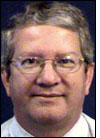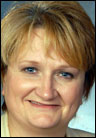For the past five years, Geisinger Medical Center, located in Danville, Pa., has employed Tug battery-powered robots from a company called Aethon to deliver medicine to patient-care units. This took some of the workload off the shoulders of its nurses and pharmacy technicians. But certain controlled substances and high-value pharmaceuticals could not be trusted to the robots. Employees had to deliver the drugs and manually record information regarding where they were moved to within the hospital, using pen and paper. But now that the drugs are fitted with passive RFID tags placed in an RFID-enabled version of the Tug known as MedEx, the robot can do the job.
With radio frequency identification—a technology that Aethon began building into some of its robots three years ago—the hospital can track which personnel loaded which robot with which medications, as well as who received them. Three of Geisinger’s five robots have been equipped with the RFID system, which it began implementing in the fourth quarter of 2009. The other two robots carry hospital equipment, but no medication, so they require no RFID tracking.
All of the Tug robots travel the floors of the eight-story health-care facility delivering medications and equipment to departments throughout several buildings, each fitted with an array of infrared and sonar sensors, as well as a laser scanner on each robot and a computer-aided design (CAD) map of the facility, to guide it from one location to the next. Based on the sensor data and the CAD drawing, the Tug transmits regular updates of its location via Wi-Fi, and can also call elevators, as well as avoid obstacles in the hallway, such as people. Once it is finished with its deliveries, the Tug—which can travel for 11 hours on a single charge—then goes to a docking station.
The robots save labor, the hospital reports, but were no help in delivering controlled medications, since regulations and the drugs’ high value require greater oversight and thorough records regarding who sent and received them. This ensures that no drugs end up missing. For the hospital’s pharmacy staff and nurses, this hand delivery of specific products can take time away from their other tasks. The solution was to put an RFID reader onboard the robot with an antenna that can capture ID numbers from any passive EPC Gen 2 ultrahigh-frequency (UHF) tags on items as they are loaded into the robot.
Aethon previously offered a similar robot, known as the Homer, with an RFID reader that identified medical devices and tracked their whereabouts by means of active UHF tags attached to those assets (see Aethon Adds RFID to Robotic Hospital Helpers).
Once Aethon had retrofitted three of Geisinger’s existing Tugs with an RFID interrogator and antenna, the system captured the ID number of every tag placed within drawers inside one of the RFID-enabled Tugs, says John Jones, Geisinger’s VP of system therapeutics. When high-value or controlled substances are first received at the hospital, information such as the type of drug, volume, expiration date and serial number is input into Aethon’s MedEx software, residing on Geisinger’s back-end server.
Staff members then place a passive RFID tag on the drug container, such as a vial or pill bottle, and read that tag with a handheld reader, thereby linking the tag’s unique ID with the pharmaceutical data. When medication is requested for particular patients, an employee picks the items out of cabinets and places them in drawers assigned for each patient-care unit. The bottom drawer is dedicated for RFID-tagged items, with the reader antenna located directly under that drawer.
As tagged items are placed in the dedicated drawer, the reader captures each ID number and links that medication with the specific robot, along with the unit to which it is destined (this information is input by the pharmaceutical staff). The worker who places those items in the Tug must first enter a password or present his or her thumbprint to the biometric reader on the Tug, thus linking that individual with that order.
The Tug then carries the items to the receiving units. Upon arriving at a unit, the robot transmits notification of its location to the Aethon software via a Wi-Fi signal. The software then displays an alert on a computer monitor used by the staff working in that unit, indicating the Tug has arrived. If there is an item in the dedicated drawer destined for that unit, a blue light is illuminated on the Tug. An employee retrieving the drugs must then enter a password, or present his or her thumbprint to the robot’s biometric scanner, which allows access to the dedicated drawer, as well as to the unit drawer containing non-tagged items.
As a staff member removes a drug from the dedicated drawer, the reader ceases to capture that item’s ID number, Jones says, and the status of that item is updated in the software, indicating it has been received at the unit, as well as which individual received it.
Although the robots are technology-agnostic, says Aldo Zini, Aethon’s president and CEO, the Tugs in use by Geisinger have Alien Technology RFID readers installed in them.
Since the RFID system was installed, the hospital calculates that it is now 40 to 50 percent more cost-effective than with human labor, says Deb Templeton, Geisinger’s VP of supply chain services. “We put together monthly metrics of the successful trips of the Tug units,” she explains, “and how that compares to the use of our staff.”
The primary advantage is seen in the evenings, Jones says, when fewer workers are on duty—or for instances when nurses may require medication from the pharmacy, but no employees are available to walk to and from the pharmacy to retrieve or deliver it. Instead, loading the Tug robot and sending it to the unit takes only a matter of minutes.
To date, Templeton says, the total number of deliveries of the RFID-enabled Tugs since Dec. 1, 2009, is 49,435, with a total number of 3,400 miles traveled. The RFID-enabled Tugs travel an average of 3.1 miles daily, with an average of 30.9 deliveries. The longest destination point from the pharmacy is 1,400 feet.



